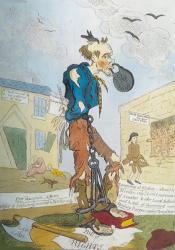The Six Acts 1819
The Six Acts created in 1819 was a set of legislation created as one of the ways the government responded to The Peterloo Massacre. The passing of the Six Acts was with hopes of monitoring and legally restricting the freedoms of the public and press. This submission created many barriers for public meetings regarding the church of state, and such meetings needed specific permission, essentially banning all public meetings. There was also a huge crackdown on what was being published by authors, especially if containing “blasphemous or seditious material” (Mather, 2014). The Six Acts were composed of the following; “The Training Prevention Act, The Seizure of Arms Act, The Seditious Meetings Act, The Blasphemous and Seditious Libels Act, The Misdemeanours Act, and The Newspaper Stamp Duties Act” (Bloy). These acts all essentially were passed to limit public meetings, increase search for weapons, and limit publications by placing regulations and taxes, giving an overarching theme of control. To kick start these acts, The Seditious Meetings Act limited public gathering and required the approval of permission from a sheriff or official. The Training Prevention Act essentially made it illegal for citizens to be trained to use firearms, while The Seizure of Arms Act allowed for increase in search for weapons in private property and the confiscation of weapons. The Newspaper and Stamp Duties Act increased taxes on publications of print and “restricted the freedom of the legitimate press”, while The Blasphemous and Seditious Libels Act doubled down on existing laws for punitive writings from authors (Bloy). The Misdemeanours Act essentially increased the court processing system by reducing chances for bail. This attempt at suppressing the push and opportunity for radical reform created a notion that there was a lack of freedom and threat towards freedom being applied. These acts were created in hopes on employing control on the population but instead it was counterproductive and create much resistance. It is important to note that there is development of the impact that politics had during the romantic era. What was considered to be radical reform was a push against the current tendencies of the state, and often spreading of messages of the opposing view of the state, views in which were rapidly spread as they would call for more freedoms. The government at this time had to do what was necessary to limit the outreach of jeopardizing opinions in order to contain and maintain control to benefit themselves. This type of control is what we continuously see many writers during this time try to speak out against through their works. All of this calls towards themes that were expressed throughout this era, themes such as individualism, freedom, and even revolution that follows certain political reform/ideology.
Works Cited:
Mather , Ruth. “The Peterloo Massacre.” British Library, 15 May 2014, https://www.bl.uk/romantics-and-victorians/articles/the-peterloo-massacre.
Sammysturgess. “The Six Acts and Censorship of the Press.” The History of Parliament, 21 Aug. 2019, https://thehistoryofparliament.wordpress.com/2019/08/20/the-six-acts-and....
“The Age of George III.” The Six Acts 1819, http://www.historyhome.co.uk/c-eight/distress/sixacts.htm.

